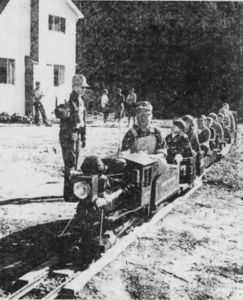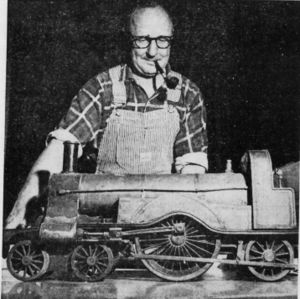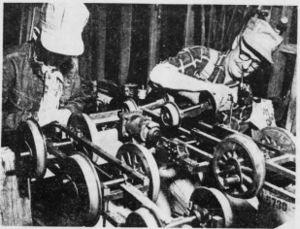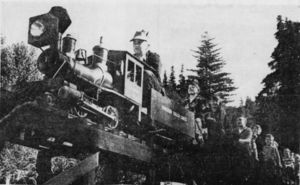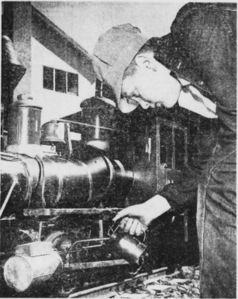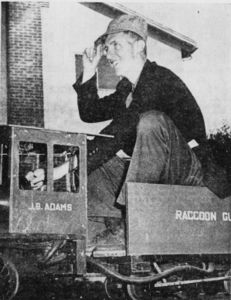Raccoon Gulch Lines
You Can Still Ride A Train In Marin, CA
Independent-Journal, Saturday, March 18, 1961
The Raccoon Gulch Lines Offer Friendly Rail Service
by Dick Steinheimer
The high cost of hauling railroad passengers has caused creased brows throughout the industry, and regular rail passenger service to Marin County is a thing of the past.
But lest the picture appear too dark, there's at least one railroad in the county to which passengers are often downright welcome.
True, the passengers must ride in freight cars and top speed is only something like 15 miles per hour, but the services is friendly.
The railroad is the Raccoon Gulch Lines of Fairfax, a 7-1/2 inch gauge line owned by Gordon B. Adams that meanders approximately one-fifth of a mile through the town's Cascade area.
Most passengers are children from the neighborhood of Adam's home at 475 Cascade Drive.
Adams, of Scotch parentage, came to the United States from Great Britain in 1947. To him the railroad on his two acre property is the expression of love for mechanics and railroading maintained since his childhood in Birmingham, England.
Patient partner to Adams in the all encompassing project is his wife, Pauline, whose residence before their marriage was in San Anselmo.
Physically, the Raccoon Gulch Lines consists of one-fifth mile of steel rails spaced 7-1/2 inches apart and weighing eight pounds per yard.
Rolling stock is modeled after old narrow gauge equipment and is one-fifth full size.
The roster includes one mock steam engine constructed by Adams from junk, spare parts and castings poured from his own patterns at the Joseph Secco Iron Foundry in San Rafael. "Steam" for the engine is provided in the form of 24 volts of electricity from several hundred pounds of storage batteries in the tender of the engine. A 24-volt motor with a five position throttle and chain drive sends power to the drive wheels.
The "passenger" equipment consists of a number of flat and gondola cars, all constructed from Adams' own design and patterns. The only assembled parts purchased for the cars were the automatic couplers.
At the tail of the train usually comes the caboose, a "crummy" complete with electric marker lights and removable cupola.
The passengers usually sit two to a car on benches or boards set athwart the sides of the cars.
Perhaps because of being a professional railroader as well as an amateur one, Adams has seen to it that his pike is complete even to having an automatic block signal system and "spring switches." The spring track swithces allow his trains to move around the reversing loops at each end of the track without the necessity of stopping before re-entering the main track.
To top it off, he proposes to begin construction soon on a wig-wag crossing signal where his driveway crosses the tracks.
What about the managing of the crowds of kids and eager parents?
Adams has informally established that the kids are invited to see the railroad when the front gate is open to the Adams' drive.
When the gate is closed operation is "private".
How about discipline?
"If the kids get too rambunctous, which is seldom, why I just tell them to go home. And you only have to tell them once." Adams said.
While the present engine is electric, plans are already well under way for operation of the line someday with steam power.
In the Adams garage rests the frame and drive wheels of a future live steam engine which Adams painstakingly plans to manufacture and assemble.
On the sawhorse alongside the steamer is the underframe of a future gasoline driven locomotive to be constructed with Adams help by one of his yound admirers, Sellar Nugent, 13, of Ross.
Sellar, a youngster knowledgeable about railroads and steam engines, plans to power the locomotive with a small Briggs and Stratton engine using chain and belt drive.
Upstairs in the Adams attic a model HO scale railroad of the era of woodburning locomotives is being built.
How did such a project ever come to dominate such a small family with no children of their own?
Adams was born in Birmingham of Scottish parents and there was raised among the industry of England's second city.
He attended the University of Birmingham and then hired out as student mechanical engineer for the London Midland and Scottish Railway and then for the London Subway System.
In World War II he became a locomotive engineer in a Railroad Operating Division in France. After the fall of France he was engaged in secret work, ending the war in the merchant navy.
The war interrupted his plans to come to the United States so he worked for the subway system until 1947 when he arrived in the U.S.
"If it means anything to anyone, I took out my citizenship papers the day after I arrived," Adams chuckled.
In 1948 he began work with Northwestern Pacific Railroad at the Tiburon round house. He was later transferred to the Southern Pacific offices in San Francisco where he is presently working as mechanical engineer.
Adams and his wife were married five years ago. They have lived in Fairfax only one year.
Adams said he had built models in Britain and had talked about it after coming here. Then one day he and his wife saw a pair of old steam engine cylinders in a Marin County junk yard and he purchased them for $2, starting the spiraling empire.
"The size of the cylinders determined the size of the railway, which was to be the 7-1/2 inch gauge," Adams said.
As to what was important, Adams admits that the backyard railroad was partially complete on the Fairfax two acres before house construction was even started.
he said they had fun on weekends coming to the site and working on the line and drinking lemonade in the shade of the oak trees on the lot.
Ties for the railroad came from scrap lumber and the small rails came from various parts of the state. Most were from small mining railroads.
Another attic project taking Adams skill as craftsman is the rebuilding of two live steam locomotives owned by Dr. L.L. Stanley of Fairfax. The locomotives were constructed in Marin county and have lain for a number of years, damaged by corrosion.
The most dramatic of the two locomotives is the breath of old-time England and of the era prior to Adams' birth. it is a scale steam model of a mighty "Stirling Eight-Foot Single," a type of fast express passenger engine built for the Great Northern Railway of England. it operated with a single 8-foot high drive wheel on each side of the engine. Fifty-three of the 4-2-2's were constructed and they hauled the majority of fast trains until the 1890's.
With block signals and other appurtenances Adams will operate his railroad this summer.
And unlike the prototypes, he never lacks for passengers.
The Raccoon Gulch Express pulls out of its "depot" with a load of youngsters from the Cascade neighborhood of Fairfax. Owner of the small railroad is Gordon B. Adams, shown piloting his electric "steam engine." Flagging the crossing is Sellar Nugent, 13, of Ross. The railroad is located on Adams' two acre property of 475 Cascade Drive. From Independent-Journal, Saturday, March 18, 1961
Backshop division of the Raccoon Gulch Lines is the Adams garage where, right, Gordon Adams works on the underframe for a live steam locomotive and left, Sellar Nugent works on his future gasoline-powered engine.
The electric-powered 2-4-0 locomotive rolls with its train across one of the Raccoon Gulch Lines trestles in Fairfax. Engineer this trip is Sellar Nugent, 13, of Ross, a model locomotive fan and helper to owner Gordon B. Adams. Passengers ride on the small gauge freight cars.
Engineer Sellar Nugent, 13, oils the valve gear of the 7-1/2 inch gauge "J.B. Adams" locomotive as it waits between trips on the Raccoon Gulch Lines in Fairfax.
Novice Engineer Dick Steinheimer, Independent-Journal reporter-photographer, takes the throttle of the J.B. Adams on a slow trip around the one-fith mile track of the home of Mr. and Mrs. Gordon B. Adams of Fairfax. The photographer was adjudged to have failed his student trip because of knees hanging out of the tender.
